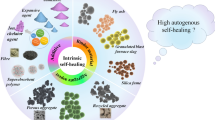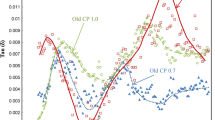Summary
A review of the present state-of-the-art in structure versus strength determinations for hydraulic cements is undertaken. Both morphological and mechanical factors are discussed. New electron micrograph studies of the hydrated material at 800 Kv are presented. Evidence is presented to show that the hydrated Portland cement is potentially a very strong material. All the data suggest that primary bonds exist between the aggregations of hydrated material. However the existence of primary bonds is not consistent with the structure of hydrated material as presented in the literature and observed by the author.
Résumé
Cet article a pour but de préciser où en est notre connaissance de la structure des ciments hydrauliques par rapport à la détermination de la résistance. On expose les études présentes et passées relatives à la structure de la pâte hydratée, y compris plusieurs études récentes faites au moyen du microscope électronique à haute tension. On montre que la structure de la pâte, telle que nous la connaissons actuellement, ne concorde pas avec la résistance potentielle du système que forme la pâte hydratée.
L'effet renforce l'hypothèse que la pâte hydratée de ciment Portland est potentiellement un matériau résistant. La résistance potentielle d'un système hydraté est déterminée d'après les valeurs du “zero-void-modulus” dont nous disposons. Les valeurs sont très fortes pour la pâte hydratée par rapport à la résistance effective de la pâte, celle-ci devant être tributaire des vides qui existent dans la structure gélifiée de la pâte.
On montre aussi que les différences entre les résistances entre action et compression du béton peuvent être expliquées rigoureusement d'après les concentrations des contraintes et qu'il n'est pas besoin d'invoquer l'existence de liaisons faibles dans le matériau hydraté. Tout manque de résistance qu'on décèle dans la pâte hydratée doit être attribué à la présence de vides ou à d'autres défauts de structure de la pâte.
Si les valeurs modulaires de la pâte hydratée n'indiquent pas un matériau à liaisons faibles, reste alors la question de savoir comment la masse hydratée est susceptible de produire un matériau à module si élevé à partir d'un enchevêtrement d'agrégats d'un matériau hydratant qui ne semble pas présenter de propriété liante primaire.
Ce problème ne peut être résolu sans une connaissance adéquate de la structure de la masse hydratante. Il s'impose donc de poursuivre parallèlement les études expérimentale et théorique afin de définir le mécanisme par lequel se développe la résistance.
Similar content being viewed by others
References
Powers, T. C. andBrownyard, T. L.—Studies of the physical properties of hardened Portland cement pastes, Proc. American Concrete Institute, 43, 1947, pp. 101–132.
Copeland, L. E. andHayes, C.—Porosity of hardened Portland cement pastes, Proc. A.C.I., 52, 1956, pp. 633–640.
Powers, T. C.—Properties of hardened Portland cement paste, Journal American Ceramic Society, 41, 1958, pp. 1–6.
Grudemo, A.—The microstructure of hardened cement paste, Paper V-2, Proc. Fourth International Symposium on Chemistry of Cements, National Bureau of Standards, Monograph 43-Vol. 2, Washington, 1962, pp. 615–647.
Copeland, L. E. andSchultz, E.—Discussion of Reference 4 in the Proc. Fourth International Symposium on Chemistry of Cements, National Bureau of Standards, Monograph 43-Vol. 2. Washington, 1962, pp. 648–655.
Hansen, T. C.—Strength, elasticity and creep as related to the internal structure of concrete, Proc. Fourth International Symposium on Chemistry of Cements, National Bureau of Standards, Monograph 43-Vol. 3, Washington, 1962, p. 710.
Copeland, L. E., Bodor, E., Chang, T. N. andWeise, C. H.—Reactions of Tobermorite gel with aluminates, ferrites, and sulfates, Research Develop. Labor. of Portland Cement Assoc., Bulletin 211.
Mills, R. H.—Influence of Water in areas of restricted adsorption, on the properties of concrete, R.I.L.E.M. 1, 6, nov.-déc. 1968, p. 553.
Krokosky, E. M. andHusak, A.—Static fatigue of hydrated Portland cement, paper submitted to American Concrete Institute, 1969.
Hale, K. F. andBrown, H. M.—High voltage electron microscopy applied to the study of cement, Fourth Regional Conference on Electron Microscopy, Rome, 1968, p. 45.
Powers, T. C.—The physical structure and engineering properties of concrete, Research Develop. Labor. of Portland Cement Assoc., Bulletin 90, July 1958.
Helmuth, R. A. andTurk, D. H.—Elastic moduli of hardened Portland cement and tricalcium silicate pastes: Effect of porosity”, Highway Research BoardSpecial Report No. 90, 1966, pp. 135–144.
Powers, T. C. andBrownyard, T. L.—Studies of the physical properties of hardened Portland cement pastes, Proc. American Concrete Institute, 43, january 1947, p. 549.
Ryshkewitch, E.—Compression strength of porous sintered alumina and zirconia, 9th communication to ceramography, J. Am. Ceram. Soc., 36 (2), 1953, pp. 65–68.
Griffith, A. A.—The theory of rupture, Proc. First International Congress on Appl. Mech., Delft, 1924, pp. 55–63.
Mc Clintock, F. A. andWalsh, J. B.—Friction on griffith cracks in rocks under pressure, Proc. Fourth U.S. National Congress on Appl. Mech., Vol. 2, pp. 1015–1022.
Brunauer, S.—Tobermorite gel—The heart of concrete, American Scientist, march 1962, pp. 210–229.
Hondros, G.—The evaluation of Poisson's ratio and modulus of materials of low tensile resistance by the Brazilian (indirect tensile) test with particular reference to concrete, Australian Journal of Applied Science, Vol. 10, Melbourne, 1959, pp. 243–268.
Di Benedetto, A. T.—The structure and properties of materials, McGraw Hill, New York, 1967, p. 301.
Personal CommunicationJ. C. Frohnsdorf.
Hayden, H. W., Moffatt, W. G. andWulff, J. —The structure and properties of materials, Vol. III, Mechanical Behavior, John Wiley, New York, jan. 1967, pp. 28, 33.
Author information
Authors and Affiliations
Rights and permissions
About this article
Cite this article
Krokosky, E.M. Strength vs. Structure A study for hydraulic cements. Mat. Constr. 3, 313–323 (1970). https://doi.org/10.1007/BF02482554
Issue Date:
DOI: https://doi.org/10.1007/BF02482554




